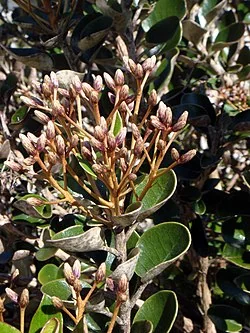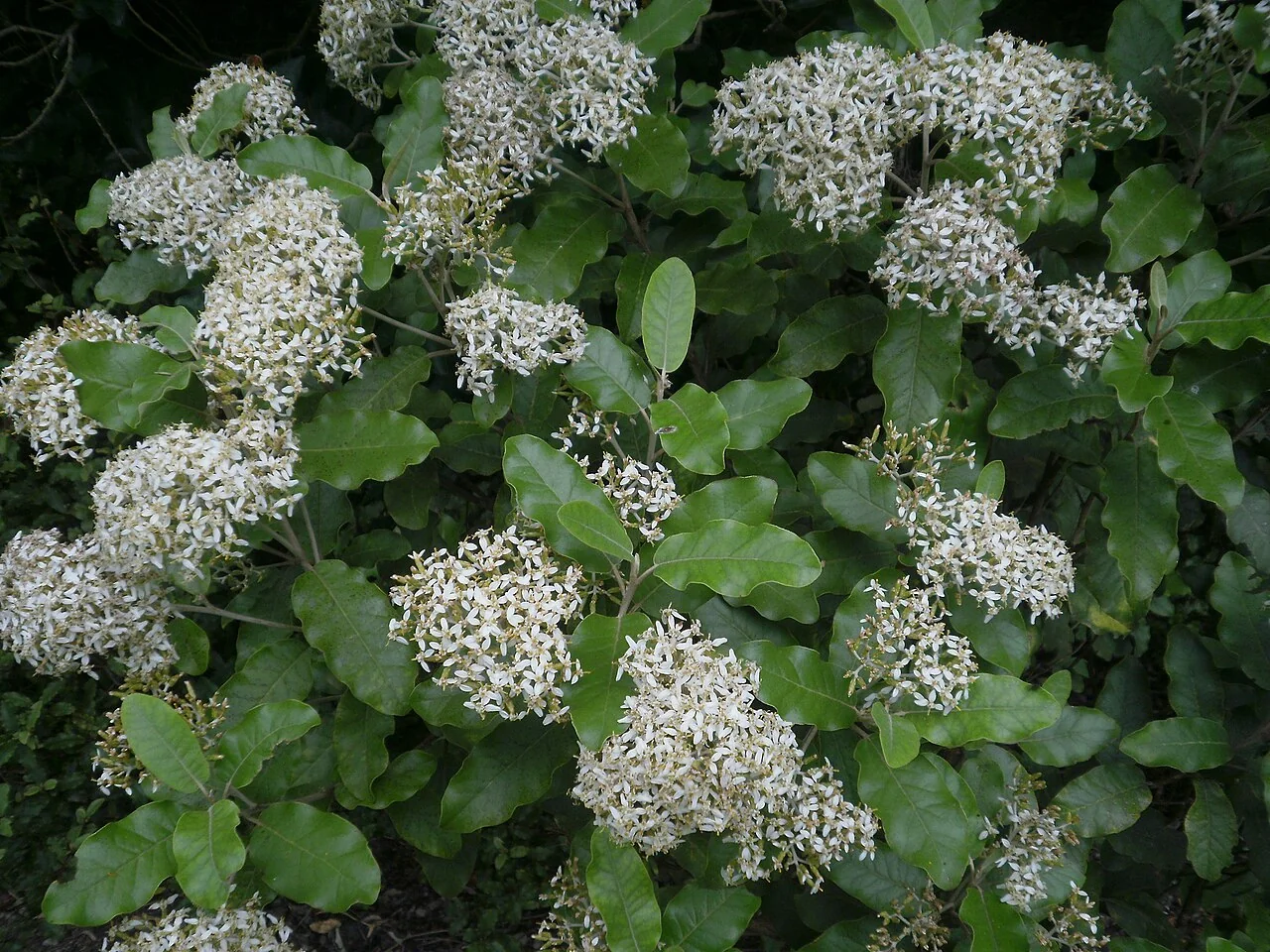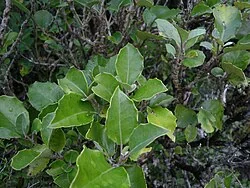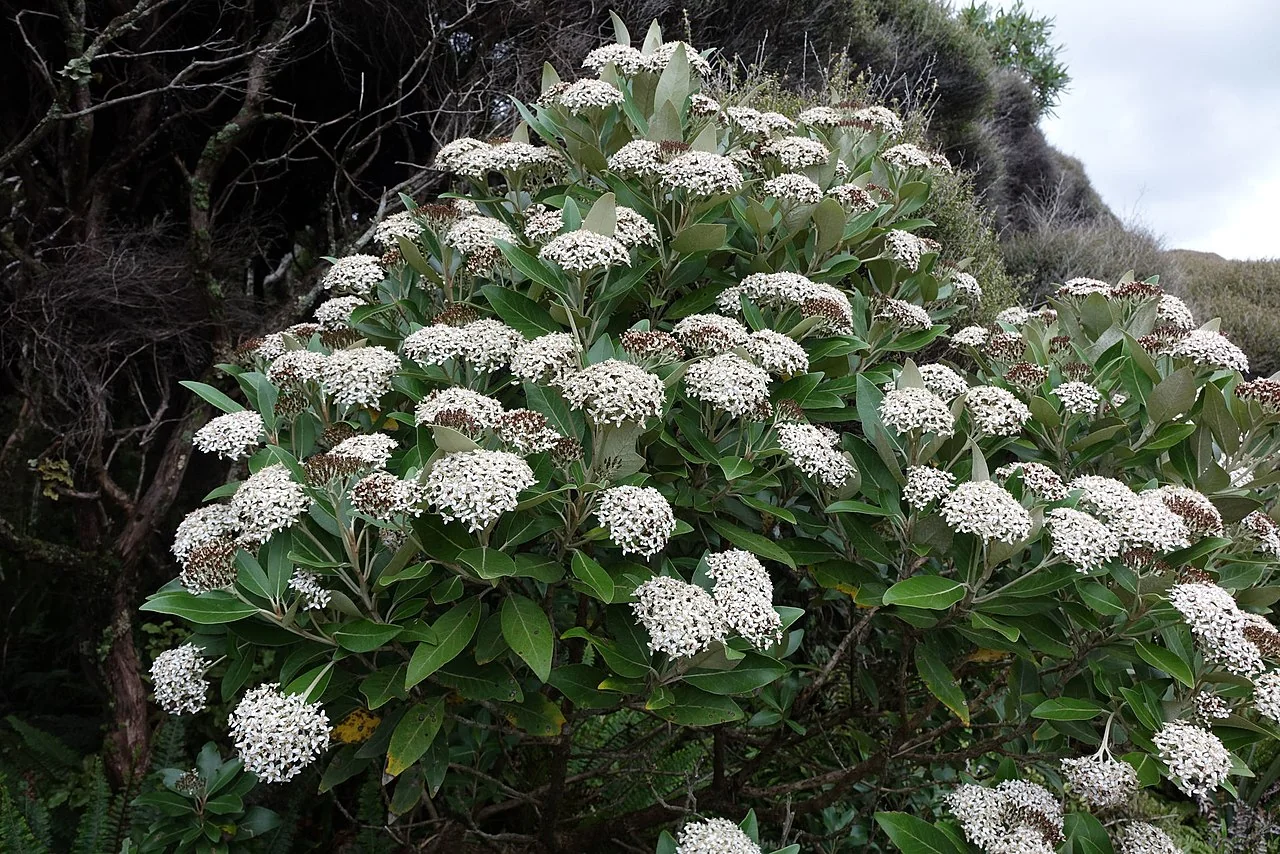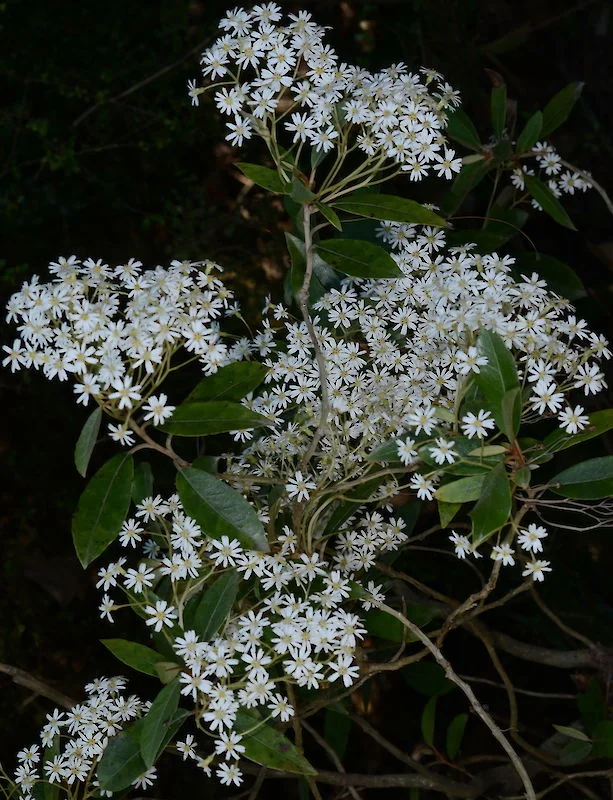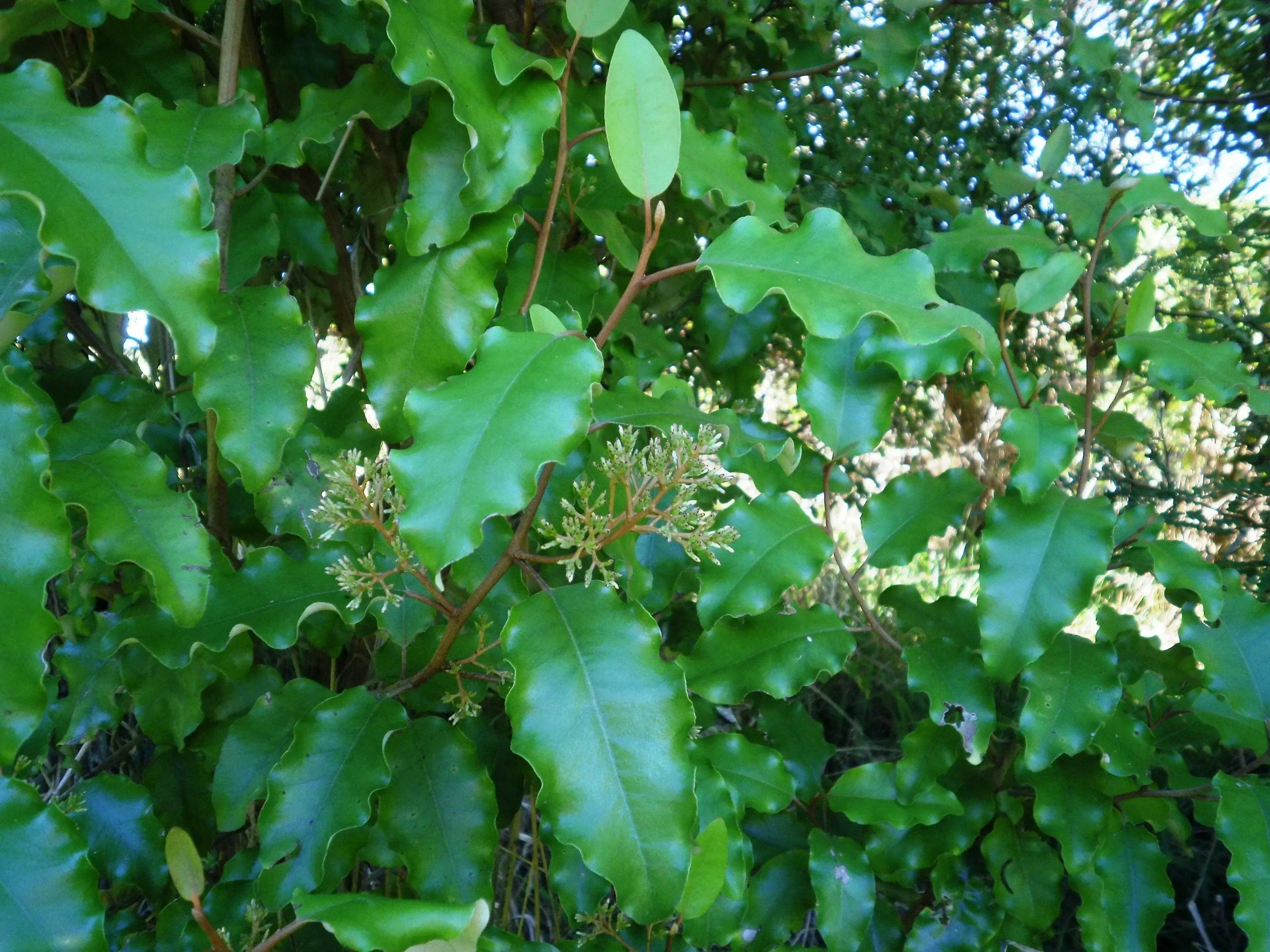
Scented Tree Daisy
Olearia odorata
Scented Tree Daisy (scientific name: Olearia odorata ) Scented Tree Daisy is a native tree daisy that produces masses of small white or cream flowers. Like other Olearia species, it's valued for its hardy nature and ability to provide shelter and nectar for native wildlife. Explore more in the native plants index .

Plant Description
Botanical Features
Scented Shrub and Kaitiaki Projects
Scented Tree Daisy ( Olearia odorata ) is a keystone of dry, open shrublands in Otago and Canterbury. Its fragrant bloom clouds with insects on still evenings. While specific customary uses are rarely documented, modern kaitiaki efforts prioritise O. odorata for soil‑binding, stock‑exclusion plantings, and as a nurse shrub for rare herbs and invertebrates. Seed collection from remnant gullies helps conserve local genetic lines in restoration corridors.
Scented Tree Daisy ( Olearia odorata ) is a small, divaricating shrub endemic to New Zealand, typically growing to a height of 2-4 meters. It has an open, twiggy, and often upright habit with many interlacing reddish twigs. Its leaves are small, light green, elliptical, often with a pale or silvery underside due to fine hairs. They are typically opposite and spathulate. It produces many small, white, intensely fragrant flowers in clusters during spring. These flowers are attractive to pollinators. It is a tough and resilient plant, able to withstand wind, drought, and coastal conditions. It thrives in well-drained soil and can tolerate full sun or partial shade.
Quick Facts
Overview
| Scientific Name | Olearia Odorata |
|---|---|
| Height | 2-6 m |
| Spread | 2-4 m |
| Water Needs | Low to moderate |
| Light | Full sun to partial shade |
| Frost Tolerance | Moderate to good |
| Salt Tolerance | Moderate |
| Growth Rate | Moderate |
| Lifespan | Long-lived |
Climate Best Suited to
Regional climate suitability across major New Zealand cities.
Regional Suitability
| Whangārei | Ideal |
| Auckland | Ideal |
| Hamilton | Suitable |
| Rotorua | Suitable |
| Tauranga | Ideal |
| Gisborne | Ideal |
| New Plymouth | Ideal |
| Whanganui | Ideal |
| Palmerston North | Suitable |
| Napier | Ideal |
| Wellington | Ideal |
| Nelson | Ideal |
| Christchurch | Suitable |
| Dunedin | Suitable |
| Invercargill | Suitable |
| City | Climate Suitability |
|---|
Natural Habitat
Scented Tree Daisy is a small divaricating shrub endemic to New Zealand, particularly common in the lake district of Otago on the South Island. It thrives in dry, open areas east of the Main Divide, demonstrating adaptability to challenging conditions such as wind, drought, and coastal exposure. It prefers regions with moderate to low rainfall and good drainage. It is highly adaptable to various soil conditions, including dry, moist, poor, rocky, or sandy soils, and can tolerate different pH levels, though excellent drainage is preferred.
Plant Conservation
The conservation status of Olearia odorata (Scented Tree Daisy) appears to have some conflicting information across sources.
According to the NZPCN and Flora of New Zealand, its current conservation status as of 2017, and in previous assessments (2012, 2009, 2004), is "Not Threatened."
However, other sources describe Olearia odorata as an important conservation species with an "At Risk - Declining" status, requiring conservation action. This classification highlights its importance for biodiversity, providing habitat for native moths and insects, some of which are entirely dependent on it.
Growing Requirements
Soil Requirements
Naturally found on dry hills and gullies; prefers free-draining, often stony or loess soils. Avoid heavy, wet clays.
Light Requirements
Full sun to light shade; more sun encourages flowering and dense divaricating habit.
Water Requirements
Low to moderate once established. Water regularly during the first two summers.
Planting Guide
When to Plant:
The optimal times for planting Olearia odorata are in spring, when temperatures begin to warm and growth starts, or in autumn, when conditions are favorable for establishment.
Site Selection:
- Sunlight: Choose a location with full sun to partial shade.
- Soil: It is highly adaptable to various soil conditions, but prefers well-draining soil. It can tolerate dry, moist, poor, rocky, or sandy soils and adapts to different pH levels.
- Space: Ensure there is enough space for its mature size, which can be up to 4 meters in height and 3 meters in spread. For hedging, space plants about 1 to 1.5 meters apart; for open garden settings, allow 2 to 3 meters between plants.
- Exposure: Olearia odorata tolerates open, exposed, and coastal locations, making it suitable for challenging sites.
Ecological Role
Twiggy tree daisy ( Olearia odorata ) is a divaricating shrub of dry eastern districts that provides exceptional shelter and insect resources.
Pollination and Dispersal
- Insect support: Abundant flower heads offer nectar/pollen to a broad insect assemblage.
- Wind dispersal: Pappus-bearing seeds colonise open, dry microsites.
Refuge and Stability
- Divaricating refuge: Interlaced twigs deter browsers and shelter small birds and lizards.
- Slope protection: Roots stabilise thin loess and terrace faces prone to erosion.
By powering pollinator webs and shielding the understorey, O. odorata is pivotal in dryland remnant ecosystems.
Uses and Significance
Practical Applications
As an "At Risk - Declining" species in the wild, Olearia odorata is a valuable plant for conservation-focused applications. It is particularly suitable for dry shelter hedges, biodiversity plantings that support native fauna, and provides a beautifully scented summer bloom that attracts a wide range of pollinators, contributing to ecosystem health.
Cultural Significance
Cultural Importance
Fragrance and Conservation
Scented tree daisy's evening fragrance and role in rare small-leaved Olearia shrublands make it a focus for public awareness plantings that connect communities with threatened dryland ecosystems.
Olearia odorata , also known as the Scented Tree Daisy, holds significant cultural importance, particularly in New Zealand where it is endemic. Its significance stems from several key aspects. The plant is highly valued for its unique aromatic qualities, particularly its fragrant flowers. This makes it a popular choice for sensory gardens and fragrant plant collections. It serves as an "excellent habitat plant for small native birds and invertebrates" and provides "essential pollinator support," especially for nocturnal pollinators attracted to its evening fragrance. Its dense, bushy growth also offers shelter for small wildlife and contributes to New Zealand's native biodiversity. Due to its hardy nature, tolerance to various conditions (including coastal and exposed sites), and drought resistance once established, it is used for hedging, screening, or as a specimen planting. It can also be used in riparian plantings and forests. Olearia odorata is classified as an "At Risk - Declining" native shrub, highlighting its importance in conservation efforts within New Zealand. It is one of eight rare Olearia species included in the Small-leaved Tree Daisy National Recovery Plan, aiming to raise public awareness and encourage its protection and management.
Landscaping Ideas
Scented Tree Daisy ( Olearia odorata ) is an exceptional native shrub that combines outstanding fragrance, wildlife value, and exceptional hardiness to create one of New Zealand's most valuable landscaping plants. This remarkable divaricating species offers sweet-scented spring flowers, dense thicket-like growth, and extraordinary resilience that makes it particularly valuable for challenging sites and conservation-focused landscaping projects.
Fragrant and Sensory Garden Applications
- Scented garden centerpieces: Small white flowers produce a delightful sweet scent during spring blooming, making it perfect for fragrant gardens, sensory spaces, and areas near seating where visitors can enjoy the aromatic experience.
- Entrance and pathway plantings: Position near doorways, gates, and frequently used paths where the spring fragrance can be appreciated during peak blooming periods, creating memorable seasonal experiences.
- Evening and relaxation gardens: Sweet scent adds another dimension to outdoor entertaining areas, patios, and evening gardens where the fragrance enhances the ambiance during spring months.
- Therapeutic and healing gardens: Aromatic qualities and wildlife value make it excellent for therapeutic landscapes where natural fragrances and bird activity contribute to stress relief and mental wellbeing.
Wildlife Conservation Landscaping
- Endemic moth habitat creation: Critical habitat for native moth species, some of which are entirely dependent on this plant. Essential for conservation-focused gardens that support New Zealand's unique biodiversity.
- Protected ecosystem recreation: Remnant populations in Otago provide habitat for native insects and moths, making cultivated specimens valuable for recreating protected ecosystem functions in garden settings.
- Conservation covenant support: Areas with this species are being protected with conservation covenants, making garden cultivation important for species preservation and genetic diversity maintenance.
- Native pollinator support: Spring flowers provide crucial nectar resources for native insects and beneficial pollinators during important breeding and establishment periods.
Structural and Screening Applications
- Dense screening solutions: Bushes up into dense thicket-like shrubs 3 m high by 3 m wide, perfect for creating substantial privacy screens, windbreaks, and visual barriers with authentic native character.
- Divaricating architecture: Open twiggy habit with intricate branching creates fascinating structural interest and provides unique architectural elements in garden design that showcase native plant diversity.
- Boundary and property lines: Excellent for defining property boundaries and creating natural fences that provide privacy while supporting conservation values and native biodiversity.
- Microclimate creation: Dense growth helps create beneficial microclimates for more tender plants while establishing shelter in exposed locations and challenging sites.
Challenging Site Excellence
- Extreme hardiness applications: Outstanding tolerance for wind, drought, frost, and coastal conditions makes it invaluable for sites where most other plants struggle to establish or survive.
- Central Otago reliability: Proven performer in Central Otago's challenging climate, demonstrating exceptional adaptability to extreme temperature variations and harsh growing conditions.
- Coastal environment solutions: Excellent tolerance for salt-laden winds and coastal exposure makes it valuable for seaside gardens and properties subject to marine influences.
- Exposed site establishment: Perfect for ridgelines, windy slopes, and areas with poor soil where its resilience provides reliable performance and gradual site improvement.
Low-Maintenance Design Benefits
- Minimal care requirements: Extremely low maintenance once established, requiring virtually no ongoing care beyond occasional light pruning, making it ideal for low-input landscaping.
- Medium growth rate: Develops at a manageable pace that allows for controlled landscape development without overwhelming smaller spaces or requiring frequent management.
- Long-term reliability: Evergreen nature and hardy constitution ensure decades of consistent performance, providing excellent return on landscape investment.
- Drought tolerance: Once established, requires minimal irrigation even during extended dry periods, making it perfect for water-wise landscapes and xeriscaping projects.
Regional and Climate Adaptability
- South Island specialization: Naturally adapted to South Island conditions, making it particularly valuable for authentic regional landscapes and endemic plant collections.
- Elevation versatility: Suitable for both lowland and higher elevation plantings, adapting to various altitude conditions across New Zealand's diverse landscapes.
- Frost resistance: Excellent tolerance for frost makes it reliable in areas subject to severe winter conditions where tender plants cannot survive.
- Wind exposure tolerance: Outstanding ability to withstand strong winds makes it valuable for exposed locations and areas requiring windbreak establishment.
Specialized Garden Themes
- Conservation and restoration gardens: Essential component of conservation-focused landscapes that preserve and display New Zealand's endemic flora while supporting threatened species recovery.
- Native moth gardens: Specialized wildlife gardens designed to support endemic moth populations, creating habitat for species that may be declining in wild populations.
- Educational and demonstration landscapes: Excellent for botanical gardens, nature centers, and educational facilities where its conservation significance and unique characteristics can be demonstrated.
- Heritage and cultural landscapes: Important for recreating historical New Zealand landscapes and demonstrating the ecological relationships between native plants and endemic wildlife.
Design Integration and Companion Planting
- Native ecosystem recreation: Pairs excellently with other South Island natives to create authentic ecosystem representations that support multiple native species and ecological functions.
- Mixed native hedging: Excellent component of diverse native hedge systems where different flowering times, textures, and wildlife values create complex, interesting boundaries.
- Transition plantings: Perfect for creating transitions between different garden areas or connecting cultivated spaces with natural areas and conservation reserves.
- Seasonal interest combinations: Spring fragrance complements other seasonal features in mixed plantings, creating extended periods of garden interest and sensory appeal throughout the year.
Seasonal Care Calendar
Spring
Plant, mulch, and tip-prune lightly.
Summer
Water new plants in drought; light shaping after flowering.
Autumn
Tidy, refresh mulch.
Winter
Minimal care; ensure drainage.
Pruning and Maintenance
Techniques and Timing
Scented tree daisy responds well to light clipping, which helps maintain its natural divaricating habit of interlacing twigs that defines this threatened species. Avoid cutting back to bare wood as this At Risk-Declining shrub requires careful management to preserve its characteristic form. The complex branching pattern benefits from gentle shaping rather than heavy pruning, particularly given its conservation status and the need to maintain habitat for associated native moths and insects that depend on this species.
How to Grow Scented Tree Daisy
Scented Tree Daisy is an "At Risk - Declining" native shrub with fragrant white flowers that support native moths and insects. This unique species is characterized by its distinctive interlacing twigs and small, glossy leaves. It is highly valued for its unique aromatic qualities and its ability to thrive in challenging, exposed sites. Understanding its propagation methods is key to successfully growing this important species and contributing to its conservation.
From Cuttings
Semi-hardwood cuttings are best taken in autumn from healthy, non-flowering shoots of this "At Risk - Declining" species. Strike rates can be variable, so multiple attempts may be necessary for conservation propagation efforts. Best results are obtained from cuttings taken after flowering and kept in a cold frame over winter with consistent humidity. Use rooting hormone and maintain careful environmental control given the species' threatened status. This method is crucial for preserving the genetic material of specific populations of this unique plant.
From Seed
Propagating Scented Tree Daisy from fresh seed is a viable method, though it requires fresh seeds and careful attention to conditions. Fresh seed offers the best viability for this threatened species, though seed has short-term storage life requiring prompt sowing. Surface-sow on well-draining mix and keep evenly moist. Seeds respond well to 5-10 days of cold treatment prior to sowing, which improves germination rates. Conservation propagation from seed is important for maintaining genetic diversity in this declining species that supports native moths and insects.
Pests and Diseases
Scented Tree Daisy ( Olearia odorata ) is remarkably resilient and generally experiences very few serious pest or disease problems when grown in appropriate conditions. Its natural adaptation to harsh New Zealand environments, including drought, frost, and coastal exposure, contributes to its robust constitution and exceptional resistance to most common garden issues.
Outstanding Natural Resistance
- General hardiness advantage: Exceptional tolerance for extreme weather conditions including wind, drought, frost, and coastal conditions provides natural resistance to stress-related pest and disease problems that affect less hardy plants.
- Disease-resistant constitution: Divaricating growth habit with open twiggy structure promotes excellent air circulation that prevents fungal diseases and other moisture-related problems.
- Stress tolerance: Outstanding ability to withstand environmental challenges means the plant rarely experiences the stress conditions that predispose other species to pest and disease attacks.
- Native adaptation: Evolved resistance to New Zealand's native pest and pathogen pressures, providing natural immunity to many problems that might affect introduced species.
Minimal Pest Issues
- General pest resistance: Tough, hardy nature makes it generally unattractive to most common garden pests, with few recorded issues of serious pest damage in cultivation.
- Browsing animal tolerance: While young plants may occasionally be browsed by introduced animals, mature plants typically establish beyond the reach of most browsing damage.
- Insect pest resistance: Dense twiggy growth and tough foliage characteristics provide natural protection against most soft-bodied insects and other common garden pests.
- Scale insect tolerance: May occasionally host minor populations of scale insects, but the plant's vigor typically prevents any serious damage or health decline.
Environmental Stress Management
- Drought stress resistance: Exceptional drought tolerance means it rarely experiences water-stress related problems that can predispose plants to pest and disease issues.
- Cold tolerance benefits: Outstanding frost resistance prevents cold-related damage and stress that might create entry points for disease organisms.
- Wind exposure adaptation: Natural tolerance for strong winds prevents wind damage that might create wounds vulnerable to infection or pest invasion.
- Coastal condition tolerance: Ability to withstand salt-laden air and coastal exposure prevents the stress-related problems that affect less tolerant species in maritime environments.
Disease Prevention and Management
- Fungal disease resistance: Open twiggy growth habit promotes excellent air circulation that prevents the humid conditions favorable for fungal development and establishment.
- Root health maintenance: Drought tolerance and preference for well-draining soils naturally prevent root rot and other water-related root diseases.
- Crown rot prevention: Divaricating growth structure allows good air movement around the plant base, preventing the humid conditions that might lead to crown rot problems.
- Stress-related disease avoidance: Exceptional hardiness means the plant rarely experiences the environmental stress that can predispose it to opportunistic diseases.
Cultural Care for Optimal Health
- Drainage optimization: Ensure good drainage to prevent any possibility of water-related problems, though this species is quite tolerant of various soil conditions.
- Air circulation maintenance: Natural open growth habit provides excellent air movement, but avoid overcrowding with other plants that might restrict airflow.
- Minimal intervention approach: This species thrives with minimal care and interference. Avoid overwatering, overfertilising, or excessive maintenance that might disrupt its natural resilience.
- Site selection benefits: Choose locations that maximize the plant's natural hardiness - well-draining sites with good exposure that allow its tough constitution to provide maximum protection.
Conservation and Wildlife Considerations
- Endemic species support: As a host plant for native moths, avoid broad-spectrum pesticides that might harm the beneficial insects this plant is designed to support.
- Integrated ecosystem management: Focus on maintaining healthy plant communities and beneficial insect populations rather than eliminating all insects, as this species plays a crucial role in native ecosystems.
- Natural balance maintenance: Healthy populations of beneficial insects help control any potential pest problems while supporting the conservation values this species provides.
- Minimal chemical intervention: Use organic or mechanical pest control methods if intervention is ever necessary, to protect the native moth species that depend on this plant.
Seasonal Health Monitoring
- Spring establishment care: Monitor young plants during their first spring growth period when they may be most vulnerable to establishment stress.
- Summer drought management: While exceptionally drought-tolerant, ensure adequate water during extreme drought for young plants still establishing root systems.
- Winter resilience: Excellent cold tolerance means minimal winter care required, though protection from browsing animals may be beneficial for young plants.
- Year-round observation: Regular monitoring is more about appreciating plant health and wildlife activity than identifying problems, as this species rarely requires intervention.
Long-Term Health Strategies
- Natural resilience support: Work with the plant's exceptional natural hardiness rather than implementing unnecessary preventive treatments that might disrupt its natural balance.
- Wildlife habitat maintenance: Focus on maintaining the plant as healthy habitat for native moths and insects rather than eliminating all insect presence.
- Stress-free cultivation: Provide appropriate growing conditions and minimal intervention to allow the plant's natural defenses to provide protection against potential problems.
- Conservation-focused management: Prioritize the plant's role in supporting native biodiversity over traditional pest control approaches that might harm beneficial species.
Scented Tree Daisy's exceptional hardiness and natural resistance make it one of the most trouble-free native plants available, requiring minimal pest and disease management while providing maximum conservation and garden value.
Bonus Tip
Expert Growing Advice
Scented tree daisy ( Olearia odorata ) is excellent for dry, open banks. Combine with matagouri and divaricating coprosmas for a tough, wildlife-friendly thicket; staggered flowering provides nectar continuity for native moths supported by this shrub.

